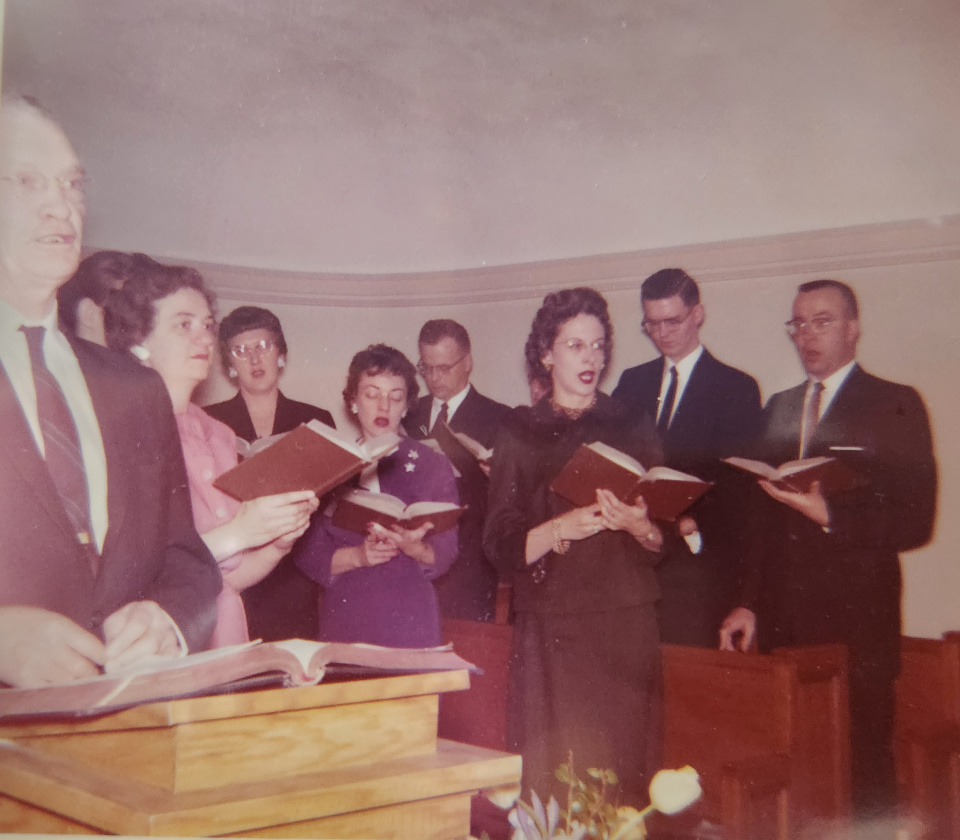Pentecost
Acts 2:1-21
When the day of Pentecost had come, they were all together in one place. And suddenly from heaven there came a sound like the rush of a violent wind, and it filled the entire house where they were sitting. Divided tongues, as of fire, appeared among them, and a tongue rested on each of them. All of them were filled with the Holy Spirit and began to speak in other languages, as the Spirit gave them ability.
Now there were devout Jews from every nation under heaven living in Jerusalem. And at this sound the crowd gathered and was bewildered, because each one heard them speaking in the native language of each. Amazed and astonished, they asked, “Are not all these who are speaking Galileans? And how is it that we hear, each of us, in our own native language? Parthians, Medes, Elamites, and residents of Mesopotamia, Judea and Cappadocia, Pontus and Asia, Phrygia and Pamphylia, Egypt and the parts of Libya belonging to Cyrene, and visitors from Rome, both Jews and proselytes, Cretans and Arabs—in our own languages we hear them speaking about God’s deeds of power.” All were amazed and perplexed, saying to one another, “What does this mean?” But others sneered and said, “They are filled with new wine.”
But Peter, standing with the eleven, raised his voice and addressed them, “People of Judea and all who live in Jerusalem, let this be known to you, and listen to what I say. Indeed, these are not drunk, as you suppose, for it is only nine o’clock in the morning. No, this is what was spoken through the prophet Joel: ‘In the last days it will be, God declares, that I will pour out my Spirit upon all flesh, and your sons and your daughters shall prophesy, and your young men shall see visions, and your old men shall dream dreams. Even upon my slaves, both men and women, in those days I will pour out my Spirit; and they shall prophesy. And I will show portents in the heaven above and signs on the earth below, blood, and fire, and smoky mist. The sun shall be turned to darkness and the moon to blood, before the coming of the Lord’s great and glorious day. Then everyone who calls on the name of the Lord shall be saved.’
Happy Birthday
The year was 1960. A plucky group of Helena residents realized that Helena, Montana was the only state capital that did not have a congregational church, and they thought that should change. So, work began on what would eventually become Plymouth Congregational Church.
Today is Pentecost, what we often think of as the birthday of the Christian church. On Pentecost Sunday of last year, 2023, we celebrated Plymouth’s 60th birthday, or the 60th anniversary of when this building was finished. It was an amazing day. We had a special service, sharing memories of Plymouth’s days-gone-by. Thirteen new members joined the church that day, one of whom was me. And, we had a special celebration that evening, which included a history presentation, an auction, and a spaghetti dinner, where we fed almost 100 people, which included many of our neighbors who had come to celebrate with us.
Unfortunately, not all of you could be here for the celebration, and some of you were not yet part of our community. So, to mark the passing of another year and to remember what happened here almost exactly one year ago, I wanted to share a little piece of that very special day, with you now. These pictures that I am going to show you were part of the history presentation that we had for the 60th anniversary:

Plymouth’s history goes back further than this building that we’re in right now. It goes back even further than when the idea for this building was first conceived. To really understand the history of congregationalism here in Helena, we need to go all the way back to 1883, when First Congregational Church was organized with 9 charter members.
This is a picture of Helena in 1870, right before that happened. There aren’t a whole lot of pictures from the early days of the Congregational Church in Helena, most of the pictures that I’m about to show you are from the “Helena as She Was” website. So, some of these pictures might be familiar to you. Even though we don’t have a picture of the church itself, or the congregation, I thought it would be interesting to give you a sense for what things were like around here during the dates that we’ll be talking about.

This the 4th of July parade on Main St. in 1890.

And, this is Spruce St, which is now Holter, taken in the 1890s. This is what the area looked like when a second congregational church was founded west of Last Chance Gulch in 1892.

This is Lawrence St. – 1895.

And, we have a bit of a time jump here, this is Main St. in 1922. This was a difficult time for the Congregationalists, and in 1931, the remaining 12 members voted to dissolve, most of them moving to the Presbyterian Church.

Here we have an aerial view of the Capitol building in 1958.

And, this is what Helena would have looked like in 1960.

Here we have a postcard showing Main St.; this is also from 1960. This is when that group of Helena residents decided that Helena shouldn’t be the only state capital without a congregational church, and decided to do something about that.

They held their first service in the Van Orsdel Chapel at the vacated Intermountain College on January 8, 1961. By the end of the month, they had adopted the name Plymouth Congregational Church, as a member of the United Church of Christ, with 76 members present at their first “joining service” on Palm Sunday, March 26.

Here we have the Rev. Guy Barnes and Ann Worcester “Wooster” breaking ground for the sanctuary in May of 1963.

And, here we have the sanctuary going up.

As we move on to the 80s, we’ll zip by the fire tower in 1974,

and the walking mall in 1978.

A wave of fundamentalism swept across the nation in the 80s, this is a picture from Park & 6th in 1980. Some people began to question whether or not it was a good thing to have a church where everyone didn’t believe the same thing.

This is Lawrence St., 1980. People asked if you could even call it a church if you were going to be so casual about what people should and shouldn’t believe, should and shouldn’t do. And, the congregation said, yes! Absolutely! More than ever, they needed to be a church, a community, where people could go and feel safe and included, even if all of their beliefs weren’t exactly the same.

In 2005, the United Church of Christ launched their “God is still speaking” campaign, with a big comma as the logo, and the slogan “Never put a period where God has put a comma.” It was a pretty controversial campaign, and a couple of TV stations actually refused to air the ads, because they featured a same-sex couple. This, of course, only drew more attention to the ads.

In 2015, Plymouth voted to be an Open & Affirming congregation, which means that we affirm the full inclusion of queer people in the life and ministry of the church.
Every Sunday, I begin our worship service with what is essentially the UCC motto: “No matter who you are, or where you are on life’s journey, you are welcome here.” The UCC is a special denomination, and Plymouth is a special part of that. We may not have started with tongues of fire appearing on top of everyone’s heads, but that doesn’t mean the Holy Spirit wasn’t moving.
We have a sort of mythical legend about how the UCC came together, how four different denominations decided for various reasons to become one church, even though what actually happened is a little bit more complicated than that. Here is a brief summary of how that all happened:
In 1930, the Congregationalist Church approached The Christian Churches in order to join together to be part of a uniting movement within the body of Christ, forming The Congregational Christian Church.
In 1934, drawn together by their common German Language and heritage, the German Reformed Church and the Evangelical Synod of North America joined together to form The Evangelical and Reformed Church. This joining was part of the strong ecumenical sentiment of the early 20th century.
Then, in 1943, in the face of WWII, the Congregational Christian Church & the Evangelical Reformed Church adopted a statement of unity, as a sign of peace, hope, and reconciliation in a world being torn apart by greed, despair, and fear. They eventually mergede in 1957 to form the United Church of Christ.
And, that’s how four churches came together to become one denomination. This is the story that we’ve told for decades. But, there’s actually more to it than that. In recent years, it’s come to light that it wasn’t actually four denominations. It was five. In 1950, the Afro-Christian Convention became part of the Congregational Christian Church, bringing with them their history of African culture and a different worldview. So, when the Congregational Christian Church merged with the Evangelical Reformed Church to form the United Church of Christ, they brought the Afro-Christian Convention with them.
The birth of the United Church of Christ was special. It represented a coming together, rather than a pulling apart, which unfortunately is how most denominations got their start. The United Church of Christ was formed out of five bodies with different theologies, different ways of governing themselves, different histories, different cultures, different ways of seeing the world, but they came together to form one church.
So, when that group of Helena residents decided to build a UCC church here in Helena in 1960, they did it for a reason. They wanted to bring that energy here to Helena. They wanted to bring that healing, uniting, loving energy here to Helena, so that the church could be an example for the people here. So that we could teach compassion, acceptance, and joy. We are a joyful church! And, we carry on that legacy, today.
So often, we focus on the sad things, the depressing things. We talk about climate change and homelessness, bigotry and greed. And, we have to talk about those things, because God wants us to talk about those things and to change those things about our world. But, we have to remember that God also created joy. God created singing. God created dancing. God created parties. There are many times in the Bible when God tells the people to have a feast in remembrance and celebration. We are supposed to have fun. We are supposed to enjoy each other’s company and make a joyful noise to the Lord. Yes, we have work to do; we have hard work to do. But, we have rejoicing to do as well.
We are doing good things here in Helena. Plymouth has long been an example for the people of this city, and we still are. We should be proud of the work that we’ve done. I know the founders of this church would happy to know about all of the things that this church as done. So be joyful, have fun with each other, do good works, and make a joyful noise to the Lord. Amen.
~ Rev. Charles Wei




